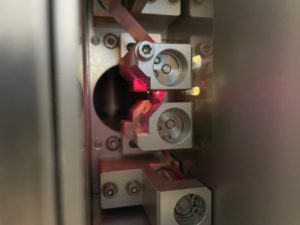Thus, both line emission radiation of the specific target material and (continuous) Bremsstrahlung forms the energy spectrum of a PXS. ELI’s PXS will offer 8 keV Cu-Ka, 11 keV Bi-La, 24 keV In-Ka, and/or 77 keV Bi-Ka radiation. The X-ray pulse duration – inherit from the driving laser pulse duration – ranges in the hundreds of femtoseconds.
The photons are emitted from the micrometer-sized plasma volume out of the vacuum chamber through an X-ray transparent window (material: Beryllium or Polyimide foil) and are focused by grazing incidence or multilayer optics onto the sample. These Montel-Optics based monochromators will be installed to generate small-focused X-ray pulses for high-spatial resolution spectroscopy and imaging. And poly-capillary optics are deployed to support absorption spectroscopy experiments at the Von-Hamos Installation. Both spectroscopy and imaging experiments will be carried out by the PXS endstation T-REX, comprising a high-precision spectrometer with Eulerian cradle and zero-noise EIGER X detector. To enhance furthermore the dynamic spectroscopy capability, continuous X-ray tubes with Cu and Mo targets are available and ready for PXS/T-REX operation.

Figure 1: Laser focus spot in front of Cu tape target (on guiding spools). The high-energetic laser pulse induces an air breakdown generating a plasma spot. Cu-Ka Line emission radiation at 8 keV and Bremsstrahlung (continuum) is not present due to the absence of the Cu target.
But the salient feature of the incoherent PXS is the fact that X-radiation is emitted in an ultrashort pulse with a typical temporal length of hundreds of femtoseconds (1e-13 s). Such short pulses will allow scientists to resolve the kinetics of chemical reactions on atomic scales via ultrafast hard X-ray diffraction and X-ray absorption spectroscopy techniques.
The inherent synchronization of the X-ray pulse to the driving IR laser will make advanced optical pump-hard X-ray probe methods feasible to study a variety of complex systems such as artificial photosynthetic systems or photoactive biological molecules.

Figure 2: Concept of PXS Beamline (here Bi/In target PXS) for operation with T-REX (Time-Resolved Experiments) end station. Montel and poly-capillary optics will focus the plasma spot onto the sample stage of the Eulerian craddle.
PXS Team:
Đông Du Mai





